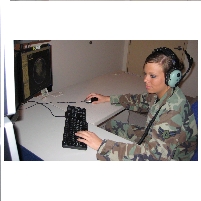Fighting the War in Afghanistan from a Computer in Nevada
Thursday, February 12, 2009
 (photo by Staff Sgt. Alice Moore, Creech AFB)
(photo by Staff Sgt. Alice Moore, Creech AFB)
Sitting in front of computer screens in a trailer truck in the Nevada desert, American soldiers pilot Predator unmanned aircrafts over the rooftops of targets in Afghanistan. As they watch live images of their target from the aircraft on their screens, they can drop a 500-pound bomb on a building 8,000 miles away at the click of a button.
War by remote control is growing and creating a fundamental change in modern warfare, as P.W. Singer, a military expert at the Brookings Institution, writes in a new book, Wired for War, The Robotics Revolution and Conflict in the 21st Century.
Indeed, the United States is increasingly relying on drones during war. According to an air force study, there was a 94% increase in combat hours flown by Predators in 2008. In addition to the military pilots at Creech Air Force Base in Nevada flying bombing missions in Afghanistan, there are robots sniffing for IEDs in the streets of Baghdad, and soldiers on the ground flying a whole array of drones over the battlefield. However, there are hazards to this remote modern warfare. It has been reported in Afghanistan and Pakistan that missiles fired by drones have often killed civilians.
There is also a strange disconnect about it, as Singer quotes one pilot saying, “You are going to war for 12 hours, shooting weapons at targets, directing kills on enemy combatants, and then you get in the car, drive home, and within 20 minutes you are sitting at the dinner table talking to your kids about their homework.”
Singer explains the other danger to this seemingly riskless warfare: that by lowering the human costs of war, we might be tempted into more wars.
America’s Predators : fighting the Afghan war from Las Vegas (by Sanjeev Miglani, Reuters)
Drone “Surge”; Predator Flights Up 94% in 2008 (by Noah Shachtman, Wired)
- Top Stories
- Unusual News
- Where is the Money Going?
- Controversies
- U.S. and the World
- Appointments and Resignations
- Latest News
- Trump to Stop Deportations If…
- Trump Denounces World Series
- What If China Invaded the United States?
- Donald Trump Has a Mental Health Problem and It Has a Name
- Trump Goes on Renaming Frenzy






Comments